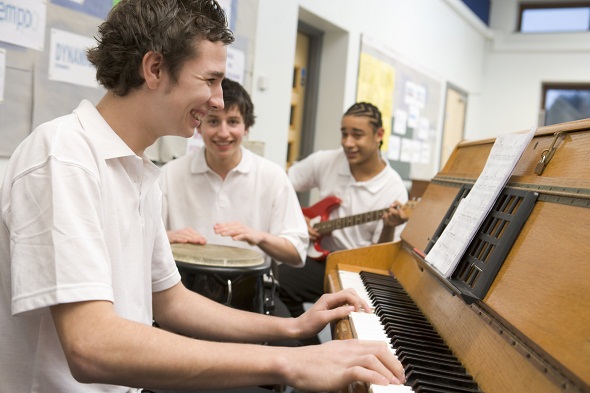
Special Education Band and Orchestra Inclusion Tips
Posted December 27th, 2012 by Coast Music Therapy
Learn ways to make music class accessible for students with autism and other special needs with these special education band and orchestra inclusion adaptations.
Music shouldn’t be ruled out as a general education class for special learners. Help out your school music teachers by sharing this article on music inclusion tips students with autism and other special needs who are interested in learning an instrument with their peers.
Although special learners may learn differently, we as teachers also have the creativity to teach differently and think outside the box in order to give students with an interest in music a chance to be a part of their peer group. Some of our favorite special education band and orchestra tips are categorized below or Download the free printable PDF version.
Buddy Assignment / Peer Pairing
Assigning another student to count along or track measures by finger helps a special learner to keep pace as well as experience peer inclusion.
Class Choice
Consider all possible tiered music ensembles available at a school before integrating a special learner in band or orchestra class. Some classes may cater to beginners while other more advanced ensembles focus on competition performance.
Color Coding
Visual information helps special learners. Color-coding software can render sheet music in which a certain note, middle C for example, displays in the color red. Placing strips of laminated red paper over the middle-C bar or key on the glockenspiel, marimba, piano, or xylophone helps special learners to recognize and associate like notes from sheet music to instrument.
Encouragement
Reward special learners with verbal encouragement when they demonstrate even the smallest success.
Highlighting
When a special learner experiences difficulty with a certain passage, highlight the passage on the sheet music to help the learner track the information more easily.
Instrument Selection
In general, non-melodic instruments, such as a bass drum, crash cymbals, or suspended cymbals, are good choices for special learners. Learners with fine motor movement difficulty should avoid attempting instruments that require digital dexterity, such as the trumpet, flute, or clarinet. Learners with gross motor movement difficulty should avoid attempting instruments that require full-arm dexterity, such as the trombone or timpani.
Mnemonics
Patterns of letters, ideas, or associations assist the brain in remembering. For example, the alphabet is easier to process when a learner can associate groups of letters to a melodic and rhythmic cue. Transferring this to musical instruction, accompany new information with a simple melody without skips.
Mnemonic Example, Set to Music
F is on the first space,
F is on the first space.
Movement
Adding movement to music accesses different parts of the brain and gives more
information to special learners. Foot- or hand-tapping also primes muscles for movement. Ask the learner to stomp to quarter notes and clap to half notes.
Music Therapy
Seek consultation from a board-certified music therapist if a special learner has difficulty that s/he cannot overcome. Search for local music therapists on the American Music Therapy Association website.
Encourage the music therapist to submit recommendations for adapting national music education standards for special learners to the National Association for Music Education
Private Lessons
Private instrument instruction provides an opportunity for special learners to practice performance in a comfortable one-to-one environment. Board certified music therapists know how to approach special learners and adapt music lessons to special needs.
Recordings
Give special learners a compact disc of recorded music, or download a digital music file to a playing device for use during practice sessions.
Sensitivity Training
Before introducing a special learner to a class, prepare typical students by
reviewing respectful behavior.
Simplified Instruction
Typical instruction: “Decrescendo in measure 16.”
Simplified instruction: “Stay quiet when the oohs come in.”
Warm-Up
Warming up primes a learner’s brain for learning. Strong slow rhythmic cues are best. Add fun and challenge to warm-up exercises for typical learners by asking them to create new rhythms at the board.
Learn Our San Diego Adapted Music Lessons»»
Get More Free Tips and Ideas from Coast Music Therapy»»














